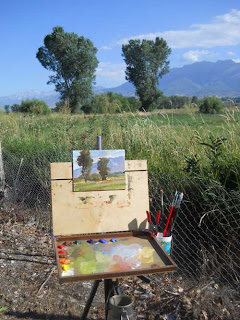Joe Bowler painting from the collection of Paul Mann
I had the pleasure last Friday night of attending the opening of this years rendition of the
Illustrators Utah! competition. This show has been a regular fixture in the
Bountiful Davis Art Center rotation of exhibits over the past decade and I have been privileged to be a part of every one of the previous shows. The show runs through November 4, 2011.
In addition to this years contemporary illustration work, there is the added bonus of an entire room dedicated to showcasing illustrator Paul Mann's collection of classic illustration. The collection includes superb examples of work from highly regarded classic illustrators such as Robert McGinnis, Austin Briggs, Tom Lovell, Robert Fawcett, Bob Peak and Joe Bowler. Anyone with a background in classic illustration will want to make the trip to Bountiful just to see these works alone.
my honorable mention winner Dog-Fish
This year I had three pieces accepted into the show.
Misty Morning,
Parade and Dog-Fish are all on display with
Dog-Fish earning an honorable mention award. Juror Robert Neubecker said he chose my piece because "who can resist a gorgeously painted snarly bulldog fishy guy". Winners included Robert Barrett's first place winning pair of paintings depicting young Barrack and Michelle Obama for a children's book project, second place winner Rob McKay's "Kitchen Conversation", Shawna Tenney's "Ghost Watcher" taking third and another honorable mention went to Hilary Onyon's "Moonrat".
If You Go: Bountiful Davis Art Center is located at 745 S Main Street in Bountiful, Utah. Hours are Tuesday through Friday from 10 am to 6 pm and Saturday 2 pm to 5 pm. Closed Sunday and Monday.
Find
Directions to BDAC here.
































